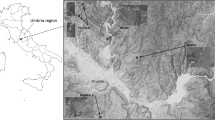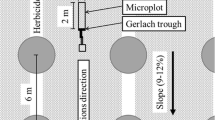Abstract
Environmental quality can be positively or negatively affected by agricultural practices depending on cropping systems and farm conditions. The Mediterranean basin is one of the 34 biodiversity hot spots on Earth characterized, among others, by the presence of ancient olive orchards. Natural value, environmental quality and cultural heritage linked to extensive farming practices would allow characterizing them as “high natural-value farmlands”. Due to the simplification of agricultural practices aimed at decreasing production costs, the practice of leaving the soil bare is widespread in Mediterranean ancient olive orchards (AOOs); consequently, degradation of soil quality and reduction of plant biodiversity are increasing. Grassingis an alternative practice based on covering the soil with selected autochthonous plant species that was proposed as an alternative to leaving the soil bare, to decrease the cost of soil management and preserving in the meantime soil quality and biodiversity. The present work regards the analysis of the impact of different soil management systems and the evaluation of two different grassing types: natural cover and seed mixtures available on market based on the species present and previously recorded in the monumental olive orchards. In the Torre Guaceto State Nature Reserve, in Apulia Region, South Italy, on the Adriatic coast, from 2011 to 2013, in six olive groves, a comparison was done considering the following agricultural practices: conventional with bare soil, organic with soil covered with seed mixtures available and organic left to natural cover. The comparison was carried on by monitoring the above ground biodiversity of the fields and by investigating the soil quality parameters (physical, chemical and biological soil properties). The research aimed (i) to further investigate whether organic farming practices are able to improve plant biodiversity and soil quality in Mediterranean AOOs; (ii) to define a minimum indicators’ set (MDS) to evaluate the agricultural practices effectiveness in the environmental performance; (iii) to achieve and collect further information about the short-term effects of the grassing on biodiversity and soil quality. Few soil quality indicators showed responsiveness in describing the effects of management systems and of the grassing on biodiversity and soil properties. Among the organic systems tested, differences were found in the performance of the different mixtures used for the grassing. A clear positive influence of the organic management systems was found on some soil quality parameters and on biodiversity.






Similar content being viewed by others
References
Arshad MA, Lowery B and Grossman B (1996) Physical tests for monitoring soil quality. In: Doran J. W. and Jones A. J. (ed). Methods for assessing soil quality, Madison, WI, pp. 123–141
Benedetti A, Mocali S (2009) Soil quality: key for sustainable production. Ital J Agron 4(1s):13–22
Bengtsson J, Ahnström J, Weibull A (2005) The effects of organic agriculture on biodiversity and abundance: a meta-analysis. J Appl Ecol 42(2):261–269
Birkhofer K, Bezemer TM, Bloem J, Bonkowski M, Christensen S, Dubois D, Ekelund F, Fließbach A, Gunst L, Hedlund K, Mäder P, Mikola J, Robin C, Setälä H, Tatin-Froux F, Van der Putten WH, Scheu S (2008) Long-term organic farming fosters below and aboveground biota: implications for soil quality, biological control and productivity. Soil Biol Biochem 40(9):2297–2308
Braun-Blanquet J (1932) Plant sociology. McGraw Hill, London
Bremner JM (1996) Nitrogen-total. Methods of Soil Analysis Part 3:1085–1121
Calabrese G, Ladisa G, Pettiti L (2012a) Oliviculture and ancient olive orchards in the EU-Mediterranean are. In: La Posta A, Lacirignola C, Mimiola G (eds) A multi-scale and multi-level approach for conservation of ancient olive orchards in the Euro-Mediterranean Region. IAMB, Bari, pp 2–23
Calabrese G, Tartaglini N, Perrino EV, Veronico G (2012b) Biodiversity and botanical characterization of four ancient olive groves in Apulia (Italy). In: Study on biodiversity in century old olive groves. IAMB, Valenzano, pp 17–61
CENT.OLI.MED (2009) LIFE+ CENT.OLI.MED: Ancient olive groves [On line]. http://www.lifecentolimed.iamb.it/ Last accessed on 24 May 2014
CEPF. (2010) Ecosystem profile – Mediterranean Basin biodiversity hotspot. Critical Ecosystem Partnership Fund, Arlington, USA
Doran JW (2002) Soil health and global sustainability: translating science into practice. Agric Ecosyst Environ 88(2):119–127
García-Orenes F, Cerdà A, Mataix-Solera J, Guerrero C, Bodí MB, Arcenegui V, Zornoza R, Sempere JG (2009) Effects of agricultural management on surface soil properties and soil–water losses in eastern Spain. Soil Tillage Res 106(1):117–123
Gil-Stores F, Trasar-Cepeda C, Leirós MC, Seoane S (2005) Different approaches to evaluating soil quality using biochemical properties. Soil Biol Biochem 37:877–887
Gosling P, Shepherd M (2005) Long-term changes in soil fertility in organic arable farming systems in England, with particular reference to phosphorus and potassium. Agric Ecosyst Environ 105(1–2):425–432
Hole DG, Perkins AJ, Wilson JD, Alexander IH, Grice PV, Evans AD (2005) Does organic farming benefit biodiversity? Biol Conserv 122(1):113–130
Klaus VH, Kleinebecker T, Prati D, Gossner MM, Alt F, Boch S, Gockel S, Hemp A, Lange M, Müller J, Oelmann Y, Pašalić E, Renner SC, Socher SA, Turke M, Weisser WW, Fischer M, Holzel N (2013) Does organic grassland farming benefit plant and arthropod diversity at the expense of yield and soil fertility? Agric Ecosyst Environ 177:1–9
Marinari S, Mancinelli R, Campiglia E, Grego S (2006) Chemical and biological indicators of soil quality in organic and conventional farming systems in Central Italy. Ecol Indic 6(4):701–711
Marzano G, Scarafino C (2012) Fauna in ancient olive orchards on Apulia region (Italy). In: Calabrese G, Tartaglini N, Ladisa G (eds) Study on biodiversity in century old olive groves. IAMB, Bari, pp 63–78
Nannipieri P, Ascher J, Ceccherini MT, Landi L, Pietramellara G, Renella G (2003) Microbial diversity and soil functions. Eur J Soil Sci 54(4):655–670
Nelson DW, Sommers LE (eds) (1996) Total carbon, organic carbon and organic matter. Methods of soil analysis, Part 3: chemical methods. Soil Science Society of America (SSSA), Madison
Nortcliff S (2002) Standardization of soil quality attributes. Agric Ecosyst Environ 88:161–168
Novara A, Gristina L, Saladino SS, Santoro A, Cerdà A (2011) Soil erosion assessment on tillage and alternative soil managements in a Sicilian vineyard. Soil Tillage Res 117:140–147
Olsen SR, Sommers LE (1982) Phosphorus. In: Page AL et al (eds) Methods of soil analysis, part 2 – 2nd edition agronomy monograph. ASA and SSSA, Madison, pp 403–430
Pascual JA, Garcia C, Hernandez T, Moreno JL, Ros M (2000) Soil microbial activity as a biomarker of degradation and remediation processes. Soil Biol Biochem 32(13):1877–1883
Perrino EV, Ladisa G, Calabrese G (2014) Flora and plant genetic resources of ancient olive groves of Apulia (Southern Italy). Genet Resour Crop Evol. doi:10.1007/s10722-013-0013-1
Pulleman M, Creamer R, Hamer U, Helder J, Pelosi C, Pérès G, Rutgers M (2012) Soil biodiversity, biological indicators and soil ecosystem services—an overview of European approaches. Curr Opin Environ Sustain 4(5):529–538
Ramos ME, Robles AB, Sánchez-Navarro A, González-Rebollar JL (2011) Soil responses to different management practices in rainfed orchards in semiarid environments. Soil Tillage Res 112(1):85–91
Rhoades J.D. (1982) Soluble salts. Methods of soil analysis. In: Page AL, Madison W (ed) American Society of Agronomy. Soil Science Society of America, pp. 167–179
Shannon CE, Weaver W (1949) The mathematical theory of communication. University of Illinois Press, Urbana-Champaign
Smith J, Doran J (1996) Measurement and use of pH and electrical conductivity for soil quality analysis In: (ed). Methods for assessing soil quality. Soil Science Society of America Special Publication pp. 169–18
Stoate C, Báldi A, Beja P, Boatman ND, Herzon I, van Doorn A, de Snoo GR, Rakosy L, Ramwell C (2009) Ecological impacts of early 21st century agricultural change in Europe – a review. J Environ Manag 91(1):22–46
ter Braak CJF, Smilauer P (2012) CANOCO Reference manual and user’s guide: Software for Ordination (Version 5.0). Microcomputer Power, Ithaca, New York
Tscharntke T, Clough Y, Wanger TC, Jackson L, Motzke I, Perfecto I, Vandermeer J, Whitbread A (2012) Global food security, biodiversity conservation and the future of agricultural intensification. Biol Conserv 151(1):53–59
United States Department of Agriculture- Natural Resources Conservation Service (2008) Soil quality physical indicators: selecting dynamic soil properties to assess soil function. USDA-NRCS, Soil Quality Technical Note No.10. Washington DC
Vance ED, Brookes PC, Jenkinson DS (1987) An extraction method for measuring soil microbial biomass C. Soil Biol Biochem 19(6):703–707
Violante P. (ed) (2000) Metodi di Analisi di Chimica del Suolo. Osservatorio Nazionale Pedologico, Ministero delle Politiche Agricole. Franco Angeli, Bologna
Wischmeier W, Smith D (1978) Predicting rainfall erosion losses: a guide to conservation planning U.S. Department of Agriculture Washington, DC
Wu J, Joergensen RG, Pommerening B, Chaussod R, Brookes PC (1990) Measurement of soil microbial biomass C by fumigation extraction-an automated procedure. Soil Biol Biochem 22:1167–1169
Author information
Authors and Affiliations
Corresponding author
Rights and permissions
About this article
Cite this article
Calabrese, G., Perrino, E.V., Ladisa, G. et al. Short-term effects of different soil management practices on biodiversity and soil quality of Mediterranean ancient olive orchards. Org. Agr. 5, 209–223 (2015). https://doi.org/10.1007/s13165-015-0120-8
Received:
Accepted:
Published:
Issue Date:
DOI: https://doi.org/10.1007/s13165-015-0120-8




